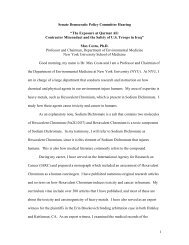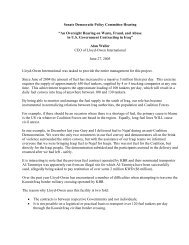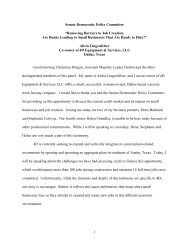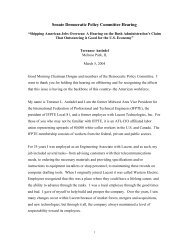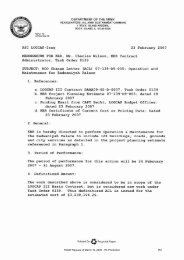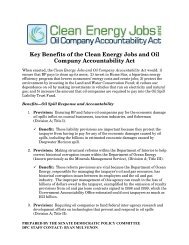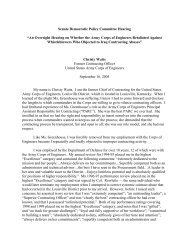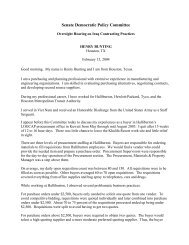Erik D. Olson - Halliburton Watch
Erik D. Olson - Halliburton Watch
Erik D. Olson - Halliburton Watch
Create successful ePaper yourself
Turn your PDF publications into a flip-book with our unique Google optimized e-Paper software.
The U.S. Army and other armed forces recognize that not only the water that is provided<br />
as drinking water must be treated to be safe, but also water that is used by the troops and support<br />
for brushing teeth and even for showering must be adequately protected. According to military<br />
regulations and the Field Manual, the types of water and its uses are:<br />
Potable<br />
Uses for Potable and Nonpotable Water 2<br />
• Drinking<br />
• Heat treatment (cold water<br />
and ice for troops)<br />
• Personal hygiene (shaving, and cleaning of<br />
equipment daily sponge washing, brushing<br />
teeth)<br />
• Food preparation<br />
• Medical staff and equipment<br />
cleaning<br />
• Hospital medical treatment<br />
Nonpotable<br />
Why “Non-Potable” (including Shower) Water Needs to be Safe<br />
• Centralized hygiene (showering)<br />
• Laundering<br />
• Preparation of human remains<br />
• Nuclear, biological, and chemical<br />
decontamination of equipment<br />
• Vehicle maintenance<br />
• Aircraft washing<br />
• Engineer construction<br />
Military regulations recognize that shower water must be chlorinated and treated to some<br />
extent to assure safety, and, as noted above, water used for personal hygiene is required to be<br />
“potable.” While non-potable water is primarily not intended for human consumption, as anyone<br />
who has ever showered knows, small amounts of water often are inhaled as aerosol or swallowed<br />
during showering. Indeed, scientific investigations have shown that waterborne disease can be<br />
transmitted simply through inhaling aerosolized contaminated shower water. 3 The Centers for<br />
Disease Control and Prevention (CDC) published a report showing that in the U.S., even an<br />
“interactive fountain” that sprayed chlorinated water into the air at a water park caused a<br />
waterborne disease outbreak of Shigella and Cryptosporidium. 4 Scientific studies have shown<br />
that for some infectious organisms like Cryptosporidium only a sip of water—indeed just a few<br />
microscopic oocysts — can make you sick. 5 Thus, water that is used for showering and for tooth<br />
brushing, and certainly even for small sips of water to take pills for example, should not be<br />
contaminated with microorganisms that can cause waterborne illness.<br />
How Non-Potable Water is Reportedly Derived and Treated at Some U.S. Bases in Iraq<br />
According to some reports, raw water is taken from the Euphrates River at a point less<br />
than two miles downstream of a human sewage discharge point. There are likely to be other<br />
human and animal fecal discharges and runoff into this major river. If this is correct, like many<br />
rivers in the United States and around the world that receive runoff and sewage discharges, the<br />
2




